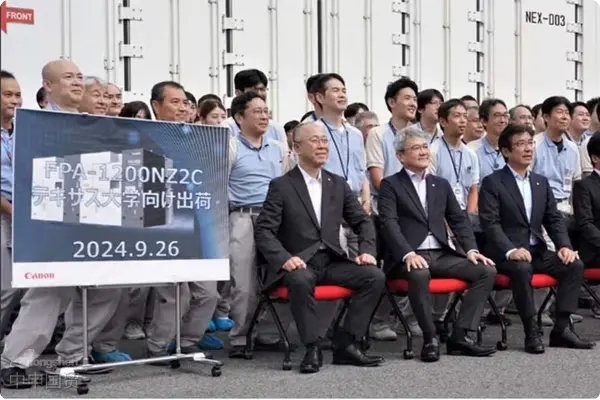- Shanghai Zhongshen International Trade Co., Ltd. - Two decades of trade agency expertise.
- Service Hotline: 139 1787 2118
Recently, Canon announced that it will supply the next - generation semiconductor manufacturing equipment for the first time, marking a major breakthrough in the commercialization of its nano - imprint technology. This batch of equipment will be delivered to the Texas Electronics Research Institute in the United States in October 2024. The institute is a government - enterprise cooperation organization supported by The University of Texas at Austin, including well - known semiconductor companies such as Intel. The introduction of this equipment will be used for the research, development and production of cutting - edge semiconductors, aiming to promote the development of the US semiconductor industry.

Innovative Application of Nano - imprint Technology
This equipment of Canon adopts the independently developed Nano - imprint technology. Different from the traditional photolithography method using strong light and photoresist, nano - imprint realizes the accurate replication of circuits by directly imprinting the mold engraved with circuit patterns onto the wafer. This method is similar to stamping with a seal, and can form complex two - dimensional or three - dimensional circuit patterns in one imprinting.
The advantage of this technology lies in that the equipment structure is relatively simple, without the need for a complex optical system and multiple sets of lenses, thus greatly reducing power consumption. According to Canon, the power consumption of the nano - imprint equipment is only one - tenth of that of the traditional photolithography method. In addition, the equipment cost is relatively low, and it can achieve the miniaturization production of semiconductors in a more economical way.
Facilitating Advanced Processes and Achieving Finer Linewidths
Canon said that this nano - imprint equipment is compatible with the fine linewidth required for manufacturing cutting - edge logic semiconductors. By improving the mold, the equipment has the potential to achieve a circuit linewidth of 2 nanometers. This is of great significance for the current semiconductor industry that pursues smaller and more efficient chips.
In an interview, Kazunori Iwamoto, Deputy General Manager of Canons Optical Equipment Business Unit, said, Our goal is to sell more than a dozen units annually within three to five years. He also mentioned that the uniqueness of the nano - imprint technology lies in its ability to form three - dimensional circuits at one time, which has broad application prospects in fields such as the production of metalenses that need to be miniaturized to dozens of nanometers.
Jointly Promoting Technological Development with Partners
Canon officially started researching and developing the nano - imprint technology in 2014 and began selling related equipment in October 2023. This supply is Canons first shipment after announcing its market launch, marking the entry of this technology into the practical application stage.
During the research and development process, Canon closely cooperated with KIOXIA Corporation (formerly Toshiba Memory) and Dai Nippon Printing Co., Ltd. KIOXIA verified the application of this equipment in flash memory production at its Yokkaichi Factory and other places, while Dai Nippon Printing was responsible for producing the molds engraved with circuit patterns. The three companies jointly promoted the practical application process of the nano - imprint technology.
Kazunori Iwamoto said that in addition to the existing partners, Canon also plans to cooperate with more companies engaged in the development and production of nano - imprint to further expand the ecosystem. He emphasized that globally, Canon is the only company engaged in the nano - imprint equipment business in the semiconductor lithography field, and the industry entry threshold is relatively high.
Reducing Costs and Improving R & D Convenience
The nano - imprint technology not only has performance advantages but also can significantly reduce production costs. Kazunori Iwamoto pointed out that according to different conditions, the cost of each photolithography process can sometimes be reduced to half that of traditional photolithography equipment. In addition, due to the small size of the equipment, it is easier for customers for R & D and other purposes to introduce and deploy.
These advantages in cost and scale make the nano - imprint technology highly competitive in the semiconductor manufacturing field, especially in the context of the current global semiconductor industry facing the dual challenges of miniaturization and cost control.
Looking to the Future and Opening up a Vast Market
With the continuous development of semiconductor technology, the demand for finer linewidths and more complex circuits is increasing day by day. The maturity and commercial application of nano - imprint technology will provide new solutions for semiconductor manufacturing. Canon plans to achieve the goal of selling more than a dozen units of equipment annually within the next three to five years to meet market demand.
At the same time, Canon is also actively expanding the application fields of nanoimprint technology. In addition to traditional logic chip manufacturing, this technology also has potential in fields that require high - precision micro - refinement, such as the production of metalenses and optical devices.
Iwamoto and Tokunori said that the difficulty of nanoimprint technology lies in achieving high - precision pattern overlay, which requires accurate positioning of the mold on the wafer. Canon has successfully overcome this challenge by leveraging the measurement technology accumulated in traditional lithography equipment, ensuring the reliability and accuracy of the equipment.
Related Recommendations
? 2025. All Rights Reserved. Shanghai ICP No. 2023007705-2  PSB Record: Shanghai No.31011502009912
PSB Record: Shanghai No.31011502009912












